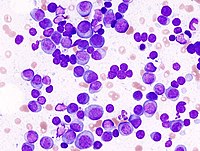
Photo from wikipedia
Introduction Clinicopathologic and prognostic significance of body mass index (BMI) in breast cancer (BC) patients remained conflicting. We aimed to investigate and modify the impact of BMI on clinicopathological significance… Click to show full abstract
Introduction Clinicopathologic and prognostic significance of body mass index (BMI) in breast cancer (BC) patients remained conflicting. We aimed to investigate and modify the impact of BMI on clinicopathological significance and survival in western Chinese BC patients. Materials and Methods 8,394 female BC patients from Western China Clinical Cooperation Group (WCCCG) between 2005 and 2015 were identified. Multivariable logistic regression and Cox proportion hazard regressions were used to examine the difference of clinicopathologic and survival characteristics between BMI categories. Results For the premenopausal, overweight and obese (OW) patients tended to have large tumor size (>5cm) (odds ratio [OR], 1.30, P<0.01) and triple-negative BC (OR, 1.31; P=0.01) compared with normal weight (NW) patients. Premenopausal underweight (UW) patients had a significantly higher risk of HER2 positive (OR, 1.71; P=0.02) and distant metastasis (OR, 2.59; P=0.01). For postmenopausal patients, OW patients showed higher risks of large tumor size (>5cm) (OR, 1.46; P=0.01), nuclear grade III (OR, 1.24; P=0.04), and lymphovascular invasion (OR, 1.46; P=0.01) compared with NW patients. An “U” shaped relationship between BMI and DFS was found (UW versus NW, adjusted hazard ratio (HR), 2.80, P<0.001; OW versus NW, adjusted HR, 1.40, P=0.02), whereas no significant difference of disease-free survival (DFS) between OW and NW premenopausal patients (adjusted HR=1.34, P=0.18) was revealed. Conclusion We concluded that UW and OW were associated with aggressively clinicopathological characteristics, regardless of menopausal status. An “U” shaped association of BMI and DFS was revealed, and no significant difference of DFS between OW and NW in postmenopausal subgroup was revealed.
Journal Title: BioMed Research International
Year Published: 2019
Link to full text (if available)
Share on Social Media: Sign Up to like & get
recommendations!